
“We’ve all been raised on television to believe that one day we’d all be millionaires, and movie gods, and rock stars. But we won’t. And we’re slowly learning that fact. And we’re very, very pissed off.”―Chuck Palahniuk, Fight Club, published 1996.
Millennials are the most narcissistic generation, fueled by our self-esteem obsessed culture, exemplified by children’s song lyrics like “I am special, I am special, look at me…” Or such is the gist of the argument San Deigo State personality psychology professor Jean Twenge has made in several books and recently, where I caught wind of this story, on NPR’s Brain Matters podcast. I’ve heard this sentiment made before. Indeed, most Millennials have heard this sentiment and have internalized it[1].
But is it true?
Are Millennials really narcissists? Let’s look at the data. Because if anything defines Millennials, it’s our trust of data over gut feelings. (I don’t have any data to back this up, but it feels right doesn’t it?)

Google a simple question, like “Are Millennials really narcissists?” and you’ll find a range of answers. Like almost any subject, you can find red-faced experts shouting at one another, carefully-crafted think pieces that “finally resolve the controversy,” and layman tiredly telling us that the answer is obvious–just look at the selfie-stick.
Whether narcissism has increased is murky, like many questions in psychology, but not unanswerable. Perhaps though the question of “Are Millennials really more narcissists than previous generations?” is too vague to have a clear yes or no answer. Do you find that disappointing? Unsatisfying? Is the lack of simple answers just yet another way you were lied to in your childhood and the world has disappointed you, Millennial?
If we define our terms well, we can arrive at a satisfying answer to the question “Are Millennials really narcissists,” or at least I can show you some data and you can come to your own conclusions.
So let’s start by defining the terms: (afterwards we’ll dig into the data itself)
First, who are “Millennials”
Urban dictionary defines the Millennial[2] as: “Special little snowflake. Born between 1982 and 1994 this generation is something special, cause Mom and Dad and their 5th grade teacher Mrs. Winotsky told them so…” As Millennial is a term from pop culture[3] and not academia, Urban dictionary’s definition is as good as any.
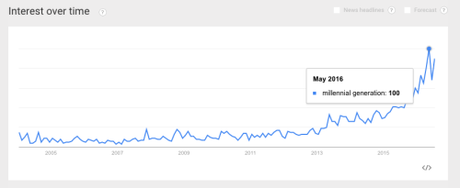
As of 2016, when I’m writing this article, Millennials are the approximately 80 million 21 to 34-year-old adults[4], who got this label because they became adults loosely around the year 2000. I fall right smack in the middle of the Millennial generation, and as such, I will speak for all Millennials[5] (/s). But as a Millennial, I will refer to Millennials with the pronoun we in this blog post.
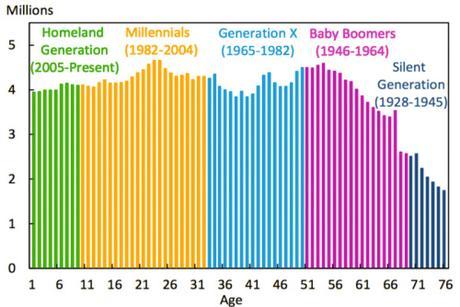
Also known as Gen Y (since the previous generation was Gen X), we are largely the children of Baby Boomers, the generation defined by the population spike following World War 2. We grew up with home computers, witnessed the Internet bloom beyond email into the modern web, and saw cell-phones shrink from antennaed monstrosities that only existed on TV into the sleek smart-phones in everyone’s pocket. When September 11th happened, we were young and impressionable but old enough to understand and remember exactly[6] where we were when we heard it happened—8th grade, in the hallway between 3rd and 5th period (Why do Millennials always have to make things about themselves). We stressed out in high school about college and if we went, we entered the work force near the Great Recession of the late 2000s.
On average, we are more educated, more diverse, and more single than previous American generations. This we know. These sorts of traits are easy to determine from surveys, but are we more narcissistic? That’s a harder question for reasons we’ll see.

Okay, so what is narcissism?
In the Greek myth, Narcissus fell loved gazing at his reflection so much he transformed into the flower we call the narcissus.
In everyday life we define narcissism a behavior similar to Narcissus in the myth: self-admiration and obsession with one’s appearance. Similarly, it’s first use in psychology, was by British sexologist, Havelock Ellis who in 1898 used the term to describe a patient sexually fixated on his own image.
However, in modern psychology, narcissism goes beyond physical appearance, and pathological narcissism is defined as “extreme selfishness, with a grandiose view of one’s talents and a craving for admiration, as a characterizing personality type.”[7] Essentially, narcissists are selfish people who want to be told how great they are, but they’re not as great as they think they are.
Subdivisions of narcissism
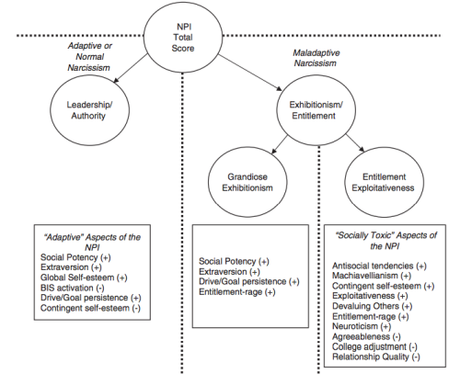
Recently, personality psychologists have made a distinction between “normal” and “pathological” narcissism. While normal or adaptive narcissism is associated with increased self-image, assertiveness, and a go-get-em attitude, pathological or maladaptive narcissism goes too far, with pathological narcissists ignoring the feelings and wishes of others and expecting to be treated as superior, regardless of their actual status or achievements. To be diagnosed medically by a psychiatrist, a person’s behavior must deviate significantly from what is expected within their culture, and it must cause significant impairments in self-function or interpersonal functioning, and these aberrant behaviors should be stable across situations, and not be due to drugs, medications, or medical conditions.
Pathological narcissism can be further split into two categories: grandiose narcissism and vulnerable narcissism.
Grandiose Narcissism
When you think of a narcissist, you are probably thinking of a grandiose narcissist. Sometimes labeled as “oblivious narcissists,” grandiose narcissists seem unaware of the impact they have on others. They are arrogant, conceited, and domineering, and in constant search for admiration. Grandiose narcissists are often exhibitionists who deny their weakness. They demand entitlement and angering at unmet expectations. They devalue people who threaten their self-esteem, and feel intense envy towards those who exceed them. When their inflated self-image conflicts with real world outcomes, they blame the world not themselves.
Vulnerable Narcissism
Also known as the “closet narcissists” or “shy narcissists,” vulnerable narcissists may appear shy or empathetic, and may suffer from low self-esteem, depends on validation from others, and experience a hypersensitivity to criticism. Paradoxically, underneath all this, they harbor grandiose fantasies, unrealistic expectations, and feelings of entitlement. Vulnerable narcissists are more aware of their failures than grandiose narcissists, but failures can lead to anger and hostile outbursts followed by shame and depression. They have anxiety in developing relationships, and sometimes this can lead to social withdrawal or avoidance.
A recent study showed vulnerable narcissists feel more comfortable communicating online through social media, and spend more time online, where presumably they can exert more control over their fragile image and protect their vulnerable egos. They are also more likely to self-report problematic relationships with social media—e.g. thinking about it excessively, having difficulty cutting back on using it. Another study showed narcissism was strongly associated with having more friends on social media. So part of the seeming prevalence of narcissism in the modern world may be from narcissists over-representation in social media.

Interestingly, the second social media study, didn’t show an increase in narcissists spending time online, perhaps because it looked at people with high narcissism, but didn’t distinguish between grandiose, vulnerable, or the non-pathological adaptive narcissists. This discrepancy brings us to the next issue, one that is crucial for determining if narcissism has increased in Millennials—how exactly do we measure narcissism, and how should we measure it?
Narcissistic Personality Inventory.
The most widely used tool measure narcissism is a survey, the Narcissistic Personality Inventory (NPI). Originally a 223-question survey, developed in 1979 to meet the Narcissistic Personality Disorder definition of the upcoming DSM-III, it was pared down to a 40-item measure in the early 1980s, which is widely used today.
This is a survey that measures narcissism in a broad sense, so it includes the positive traits of adaptive narcissism, like being assertive, in addition to measures of maladaptive narcissism. Therefore it is hard to distinguish from the results of this survey alone, whether a person displays maladaptive narcissism.
Later researchers analyzed NPI results and showed that groups of responses were correlated with each-other either positively and negatively. For example, the type of person who answers yes to “I see myself as a good leader,” probably also agrees with the statement “I am a born leader,” but this seems to have no relation with whether they agree with the statement “I like to look at myself.”
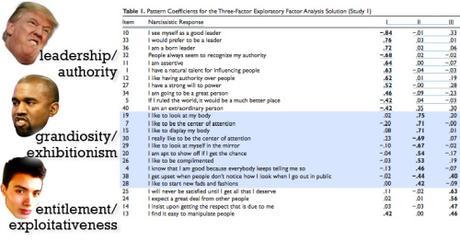
Based on these kinds of patterns proposed that narcissism isn’t a single-dimensional measure, but rather a group of inter-related personality traits such as Leadership/Authority, Grandiosity/Exhibitionism, and Entitlement/Exploitativeness. What study used this breakdown, 11/40 questions fell into the adaptive Leadership/Authority category, more than did so for either Grandiosity/Exhibitionism, and Entitlement/Exploitativeness, showing that this survey isn’t great for detecting maladaptive narcissism.
So perhaps we shouldn’t think of narcissism as a one-dimensional line that goes left to right, with low self-esteem on the left, adaptive narcissism in the middle, and maladaptive narcissism on the right, but rather a three three dimensional space, with the x-axis representing Leadership/Authority, y-axis Grandiosity/Exhibitionism, and z-axis Entitlement/Exploitativeness.
To make this more concrete, let’s imagine that two people, Peter and Sarah, got equal scores on the NPI:
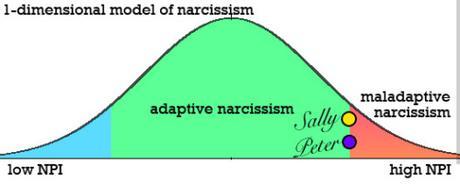
However, when we breakdown their answers we see very different patterns. Peter’s score resulted largely from his grandiosity and entitlement, whereas Sarah’s resulted from her belief in her leadership abilities:

This example illustrates an extreme case of how NPI-lump-sum scores can be difficult to interpret.
Another way to look at whether the NPI lump-score is a good measure for pathologic narcissism is to give people the NPI survey, but then test them for the traits we are interested in to see how the NPI correlates with those traits. The NPI lump-score shows more correlation with normal personality traits like extroversion than it does with the more recently developed and specific Pathological Narcissm Inventory, Pincus et al. 2009, which was specifically designed and validated to separate between pathological and normal narcissism. This lined up with a review by Pincus and Lukowitsky 2010, which suggested that NPI lump-score measures normal adaptive narcissism more than pathological narcissism.

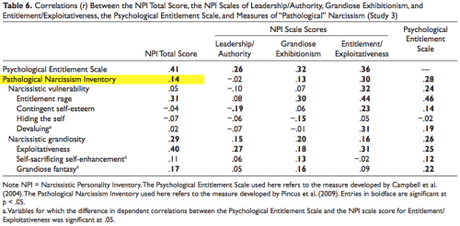
However, while the NPI had a low correlation with the Pathological Narcissism Inventory, it did correlated with traits like entitlement rage, exploitative-ness, and grandiose fantasies.
How Do Scientists Measure Changes to Narcissism Over Time?
Narcissism can change over-time between generations, but it can also change over-time as an individual ages. Because of this it is important to look at studies that use a time-lag method, which analyzes people of the same age at different points of time. And because the NPI is an old survey and widely used, a lot of the data that exists, comes from the NPI, and most of the information available is just the lump-scores, not the actual results of each question. The NPI may not be ideal, but it’s what we’ve got, and we can’t generate data backwards in time with surveys that better measure what we’re probably more interested in, characteristics like grandiosity and entitlement.
So finally… Are Millennials More Narcissistic Than Previous Generations
Well, something is changing, that much is sure. Twenge, the San Diego psychologist and “Millenials are narcissists” alarm-sounder I mentioned before, conducted a meta-analysis on the mean reported NPI-lump-sum scores from 85 studies (which together totaled 16,475 students), and showed a statistically-significant increase in their NPI scores over time[8]:
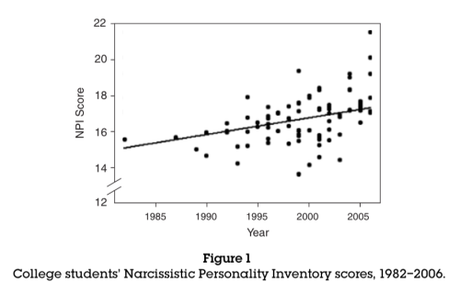
Remember though, the NPI doesn’t just measure pathological, mal-adaptive narcissism, but also adaptive narcissism which is associated like extraversion, assertiveness, self-esteem, and agency—all of which, as Twenge notes in the study had been reported to increase over this same time period. Also note, the rise is continuous, there is no sharp rise denoting some generational split or the sudden effect of a new technology or parenting fad.
Also, a smaller subset of the data allowed responses to be separated between male and female students. This data showed that: “College men’s NPI scores are not significantly correlated with year (β=.16, ns; k=44, d=0.12), but college women’s scores are (β=.46, p<.002, k=44, d=0.28).” The lack of significance does not indicate that a trend did not exist for men[9], suggesting that the increases in NPI scores may have been larger in women, and could relate to positive trends like increasing assertiveness, self-esteem, and leadership in young women. Indeed, the sex differences significantly declined over this period, though men still show higher NPI scores, as of 2006.
Conclusions
So the most often-mentioned data of this trend shows that the NPI is increasing over the time. Whether this is due to increases in gender equality or entitlement seems unclear. Is it due to extroversion or exploitative-ness, I don’t know. Also, whether it is a change that has only occurred in the new generation, or a general trend is unclear. Are the baby-boomers more narcissistic than their parents were at the same age?
A Chinese co-worker once recounted to me her mother’s advice, which shocked me as it contrasted starkly with my American self-esteem valuing childhood. When she was a child, her mother told her, “You’ll never be the best at what you do–someone will always be better than you. So, you need to learn to come to terms with that and find enjoyment in what you do outside of achievement and being the best.” This woman went on to be a high school track star, get a PhD in biology, and become a staff scientist at MIT, the whole time clinging to her mother’s words as good advice.
Maybe as a result of similar cultural attitudes, Twenge points out that Asian Americans report the lowest self-esteems, but also the highest achievement in many domains. Twenge argues Asian Americans show esteem is not necessary for achievement, and therefore blindly praising our children will not make them more successful. Instead we should praise their efforts when they succeed.
Somewhere in between my Chinese coworker’s mother’s advice and the esteem-boosting lies we were fed as American Millennials, is the ideal parental advice according to a show I adore, Community:

“Jeff’s Mom: [voice over in his memory] Jeff, you’re a normal person. There’s nothing very special about you at all. You’re going to be great at a few things, but really crappy at many more. And that takes a lot of the pressure off, so you can live a full, happy life. Oh, and sorry it took me so long to tell you that, and it was only in your imagination. My bad. Kind of a sloppy mom.
Jeff: [quietly to himself] That’s okay, Mom. Nobody’s perfect.”
If you liked this blog post, you might also like another I wrote on intergenerational differences, happiness and life satisfaction: Frames of Reference – Why Smart People Feel Stupid, Money Buys Happiness, and You Will Never Feel Truly Satisfied
Also, I researched and wrote this for free out of the goodness of my heart (and an insatiable need for the approval of strangers), so if you liked this article please share it, or follow me to get notified about future articles. And if you didn’t like the article, write a comment if you please about why it was a piece of shit.
Footnotes (Tangents/Bad Jokes)
[1] Though older generations rate Millenials as more narcissistic than Millenials do themselves.
[2] This line is to be read in a self-aware ironic voice, perhaps imitating of a middle-schooler giving a presentation in class
[3] It was first coined in 1982 by pop-historians, demographers, and business-partners Neil Howe and William Strauss, according to USA Today. Mr. Howe also states the generation spans from about 1982 to 2004. In their 2000 book, Millennials Rising: The Next Great Generation, they assigned the generation seven “core traits”: special, sheltered, confident, team-oriented, conventional, pressured and achieving. Now Howe gives about 60 speeches a year at schools and corporations, and consults on ways that these institutions can better engage and communicate with Millennials.
[4] Which means notable narcelebs Kim Kardashian and Kanye West are Gen Xers.
[5] Interestingly, Howe and Strauss, who coined the term Millennials, based their portrait of the generation on surveys of high-schoolers and teachers from my home town, Fairfax County, VA, so in a strange way maybe I am particularly representative of this generational stereotype.
[6] Or think we remember exactly where we were anyway. The intense “flashbulb memories” that accompany events like Pearl Harbor, the JFK assassination, or the O.J. Bronco Chase are just as susceptible to distortion as other memories.
[7] Of course many definitions of narcissm exist, especially because it is studied by a variety of fields: psychiatry, clinical psychology, personality psychology, etc., and research into narcissism is said to suffer from a “criterion problem,” where different definitions of what narcissism is used by different researchers make it difficult to compare and interpret data.
[8] The mean increased one third of a standard deviation.
[9] Note, statistical significance with one gender and not the other does not prove a gender difference. For example, perhaps the sample was too small and the trend was lost in the noise of the data, especially if they both trended the same direction. To prove a gender difference that has to be assessed specifically with a different statistical test.

